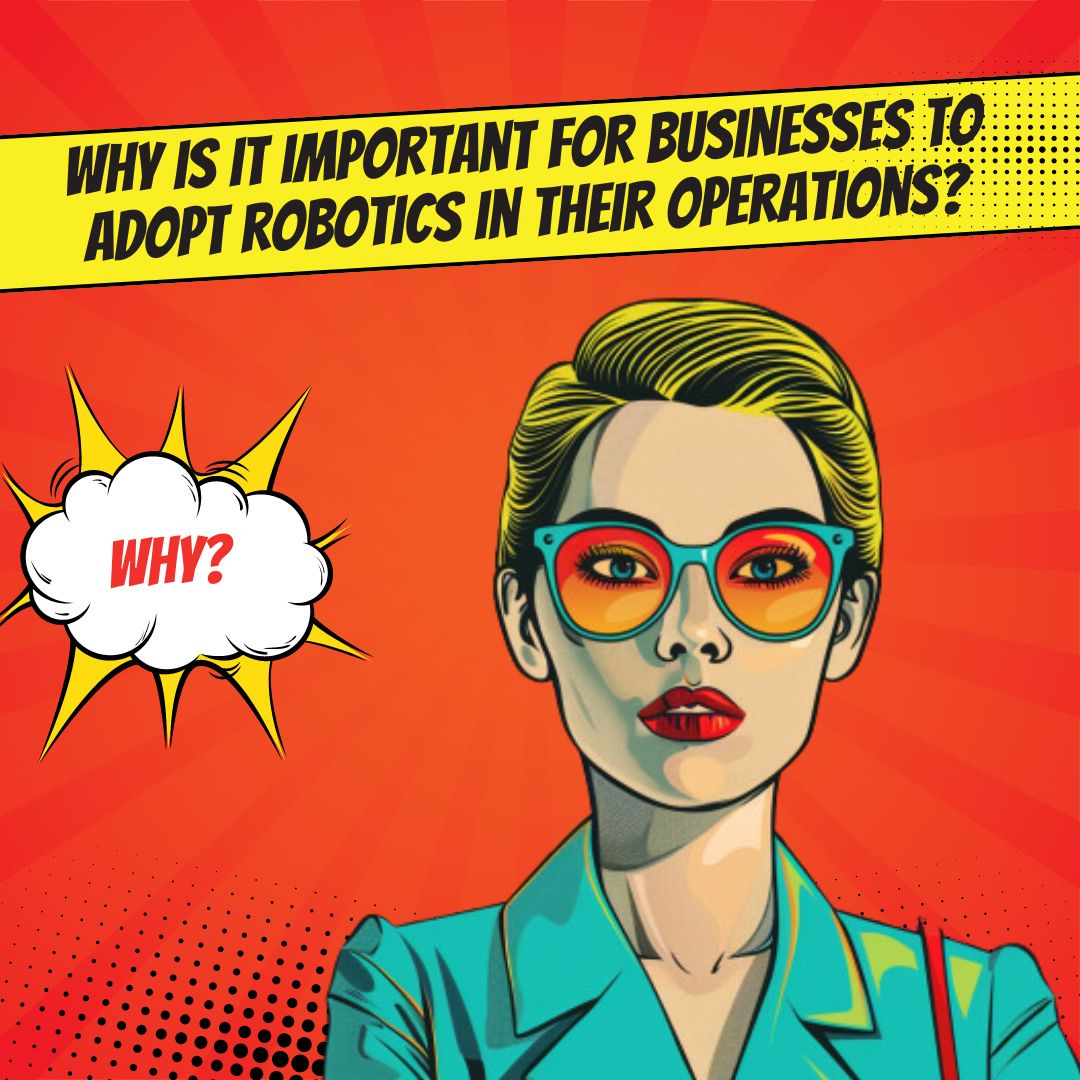Key Takeaways
✅ Strategic Planning: Crafting a plan to welcome robots into your business isn't just about following trends – it's about making sure these metal helpers align with your vision. Could they save costs? Boost productivity? It's not just about the bots, it's about the impact on your team and culture, too. Get your strategy straight, and you'll be set for smoother sailing.
✅ Technology Selection and Implementation: With all the tech out there, you've got to pick the right fit. It's like choosing a new smartphone – you want one that's easy to use, versatile, and plays nice with your other gadgets. Once you've chosen your robotic ally, ensure your team knows how to work with it – it'll make the transition as smooth as a robot's dance moves.
✅ Continuous Improvement and Adaptation: Here's where you keep your robots – and your business – in tip-top shape. Regular check-ups are a must to stay ahead of the game. You might even find new ways robots can lend a hand. Stay sharp, adapt, and watch your business soar to new heights with the power of automation.

Introduction
Ever wondered what it would be like to have a team of robots working for you? Sounds like a scene from a sci-fi movie, right? But it's not as far off as you might think. Integrating robotics into business operations has become a game-changer for many industries. It's not just about the cool factor – it's about driving your business towards unmatched success.
Is your business ready to join the automation revolution? Are you looking to improve efficiency, save costs, and stay ahead of the curve? Here's the secret: robotics can be your golden ticket, but only if you know how to play the game. With this article, you're about to unlock a treasure trove of insights into how robotics can elevate your enterprise and skyrocket your success.
We're not just talking about hypothetical success stories here. We're diving into the nitty gritty—modern trends, actionable advice, and innovative solutions that could seriously bump up your revenue and ROAS/ROI. Stick with us, and by the end of this article, you'll be buzzing with groundbreaking information that's tailor-made for turning your robotic dreams into reality. Ready for the adventure? Let's get started!.

Top Statistics
| Statistic | Insight |
|---|---|
| Global robotics market size | Projected to reach $176.8 billion by 2025, the exponential market growth showcases the boiling point robotics technology has reached - pivotal for businesses pondering whether to adopt it. |
| Industrial robotics growth | Expected to mushroom to $86.6 billion by 2027, this growth trend signals that industrial settings are ripe for robotics, paving the path for a new era of automation. |
| Adoption of collaborative robots | With a surging CAGR of 30.3%, cobots are not just a fleeting trend; they're a vivid testament to the growing collaborative work between humans and robots in the workplace. |
| Automation in supply chain | A striking 73% of supply chain professionals see automation reshaping their industry, marking a transformative period for operational efficiency. |
| Impact of COVID-19 on robotics | A 30% uptick in robotics orders during the pandemic speaks volumes about how crises can fast-track innovation and adoption of resilient technologies. |
Assessing Business Needs
Have you ever watched those robots in car manufacturing documentaries and wondered if they'd fit in your workspace? It's not just about the cool factor; it's assessing where robotics can genuinely contribute. It involves taking a hard look at your workflows. Are there repetitive tasks that drain your team’s energy? Places where errors creep in because, well, we're only human? Identifying these pain points isn’t just about fixing what’s broken; it's about unlocking potential where you didn't even know you had it. Analyzing your business processes means you're halfway to making a decision that could rocket your productivity to new heights.

Choosing the Right Robotics Technology
Imagine walking into a tech store with every gadget you can think of. That’s what you’re doing when picking out robots. You’ve got industrial robots that handle heavy lifting, collaborative robots or 'cobots' that work safely alongside your team, and autonomous mobile robots that zip around like helpful bees. But which one suits your hive? You've got to think about how much you can spend (cost), how your needs might grow (scalability), and whether these machines play nice with the gear you've already got (compatibility). This is a bit like matchmaking – it has to be the right fit for a lasting relationship.
Developing a Robotics Integration Plan
Setting out on this robotic journey without a map is like hitting the road without GPS – it’s just not a great idea. You need a rock-solid plan that spells out all the steps. Creating a detailed integration plan might not be as thrilling as picking out your new robot friends, but trust me, it's vital. It includes when and how you'll make the shift (your timeline), how much cash you'll lay down (budget), and the people and tools you’ll need (resources). And goals? You've got to be clear on what success looks like – otherwise, how will you know when you get there?
Training and Upskilling Employees
Sure, those robots might be the main characters, but your employees are the heroes in this story. Without the right training programs, your shiny new robots won’t be nearly as effective. And what about when jobs change because of this high-tech help? That’s where upskilling comes in. It’s helping your team grow new muscles for this bionic age of work. Will they be scared? Maybe. But there's also hope – a chance to become more skilled and valuable. So, nurturing a culture where learning is part of the job can turn nervousness into excitement..

Implementing and Monitoring Robotics Systems
Alright, the big day is here – robot deployment! It's like a space mission; you're sending these robots to explore unknown territories of your workflow. So, you execute your integration plan and keep an eye on how things are going, squashing bugs and tweaking things to perfection. Monitoring performance is non-negotiable because - surprise! – not everything goes according to plan. When you’re cozied up to this new robotic landscape, you’ll want to keep track of how it’s all ticking along and ensure it's delivering the dream efficiency you imagined.
Embracing Continuous Improvement
Launching robots into your processes isn't a one-and-done gig. It would be nice if it was, but this is more of an ongoing series than a single movie. Your plan needs regular check-ins and tune-ups. What's new in robot land? Could it be even better than what you've got? Incorporating new technologies and best practices means you're keeping pace with the world, not getting left behind. Fostering a work culture that's all about getting better every day – continuous improvement – that's the golden ticket to making the most of your robotic teammates.
By integrating robotics into your business operations with a strategic and employee-inclusive approach, you're not just buying into new tech – you're buying into a future of possibilities. Are you ready to start plotting the course to your own robotic revolution?

AI Marketing Engineers Recommendation
Recommendation 1: Start small with Integrating Robotics into Business Operations: A Roadmap for Success: Begin by identifying repetitive, time-consuming tasks within your business that could be automated. Have you observed employees spending hours on tasks that a machine could do? Start there. Use data to back up your decision – look at labor hours, error rates, and the potential ROI of automating these tasks. For example, if data shows that your packing department is the bottleneck in your supply chain, consider a robotics solution that streamlines picking and packing. Remember, small wins can pave the way for broader acceptance of robotics in your organization.
Recommendation 2: Ensure Alignment with Business Goals and Workforce Involvement: Before diving into the deep end, ask yourself: How will Integrating Robotics into Business Operations enhance my overall business strategy? It's crucial to ensure your venture into robotics aligns with your business goals. Are you looking to improve efficiency? Or maybe your focus is on enhancing product quality? Stay on top of current trends, such as the move towards sustainable production or the integration of IoT with robotic systems, and consider how these trends support your objectives. At the same time, work closely with your employees who may fear job displacement. Educate and re-skill your workforce to work alongside robots, turning potential fears into excitement for a technologically empowered future.
Recommendation 3: Select the Right Partners and Tools: Once you’ve decided to introduce robotics into your operations, it's time to pick the right partners and tools that will help you succeed. Are you aware of the plethora of robotics solutions out there, and which is the fit for your business needs? Look for industry-standard certifications, user testimonials, or case studies to evaluate reliability. Arrange demonstrations to see the robots in action and consult with experts who can tailor solutions to your context. Keep an eye on tools like robotic process automation (RPA) software that can offer quick wins in office-based tasks, or versatile collaborative robots (cobots) that can work safely alongside humans. It’s not just about having robots; it’s about having the right robots and the know-how to integrate them seamlessly into your existing ecosystem.

Relevant Links
Robotic Automation – Your Future Workforce Awaits!
Maximize Your ROI with Groundbreaking Robotics Integration
Revolutionize Your Business with Expert Guidance
Unlocking Efficiency: The Ultimate Guide to Robots in Your Business
Stay Ahead in Business with Cutting-Edge Tech!
Top Robots of the Year: Transform Your Workflows Now!
Unleash the Power of AI in Your Marketing Strategy
Leverage AI for Next-Level Growth: Essential Tactics for Every Business
Conclusion
As we wrap up our journey through the roadmap for integrating robotics into business operations, it's clear that we're standing at the threshold of an exciting new era. The potential to transform our workplaces with efficiency, precision, and even a new kind of partnership is huge, but so is the challenge of doing it right. Have you thought about where robots might fit into your business? It's fascinating, isn't it, to imagine these tireless machines enhancing what we do every day?
Remember, diving into the world of robotics isn't about bringing in shiny new toys; it's about strategic planning and asking the tough questions: Where will these robots have the biggest impact? Will they make your processes smoother? How will your talented team adapt and grow alongside these high-tech helpers? Make no mistake, the businesses that thrive in the future will be the ones that have not only upskilled their employees but that have also built a strong foundation ensuring their robotic coworkers are adding value, not chaos.
But don't stop there. After all, any business worth its salt knows that refinement is key. Keep a keen eye on your bots and processes. Are they delivering as expected? How can you make good even better? With a culture of continuous improvement, the possibilities are boundless.
So, as you look forward toward this bold new world of robots in the workplace, think carefully about your own roadmap for success. How will you navigate this transition? How will you ensure your business doesn't just survive, but thrives? If this journey intrigues you, there's no better time than now to take that first step. Are you ready for the adventure?

FAQs
Question 1: What is robotics in the context of business operations?
Answer: Think of robotics as your high-tech helper in the business world. We're talking about smart machines designed to take over tasks and make things run smoothly, like a Swiss watch. They're not just for show; they boost efficiency and get the job done with a touch of that futuristic flair.
Question 2: Why should a business consider integrating robotics into its operations?
Answer: Here's the deal: bringing robots into the mix can up your game. We're seeing less grunt work for humans, more consistency in the results, and the bonus? Safety gets a big thumbs up. Robots can handle the hot, heavy, or just plain hazardous stuff.
Question 3: What are the key steps to successfully integrating robotics into a business?
Answer: You want success with bots? Start with a game plan. Pick out where they can shine, crunch some numbers to see if it's worth the investment, choose the tech that fits, teach your team the ropes, put it all in play, and keep an eye on things to keep it all ticking along nicely.
Question 4: What are the most common applications of robotics in business operations?
Answer: Robots are getting jobs all over the place: in factories, warehouses, handling packages, keeping stock in check, and even dabbling in customer service or number crunching. They're the new versatile workforce.
Question 5: How can a business assess the feasibility and ROI of integrating robotics?
Answer: Before jumping on the bot bandwagon, take a look under the hood of your business. What's it going to cost, and what are the perks? Try out a mini version of the plan to get a feel for how it'll pan out.
Question 6: What are the key factors to consider when selecting the right robotics technology for a business?
Answer: Choosing the right bot buddy is crucial. Think about what you need, the complexity of tasks, your spending limit, whether it'll play nice with your current systems, and if you need a special touch – a tailor-made solution.
Question 7: How can a business ensure a smooth transition to robotics-integrated operations?
Answer: Make it smooth as silk by planning well, keeping everyone in the loop, buffing up your team's skills, and easing into the robotic revolution step by step to avoid chaos.
Question 8: What are the potential challenges and risks associated with integrating robotics into business operations?
Answer: It's not all rainbows and butterflies; shelling out the initial cash, hitting technical snags, the human team getting chilly feet, and the bots needing regular tune-ups are part and parcel of it. Plus, there are cyber baddies to watch out for and the delicate dance of keeping jobs while the robots rise.
Question 9: How can a business ensure the safety of employees when integrating robotics?
Answer: Play it safe by sticking to the rulebook, giving your workplace a once-over for any robot-related risks, kit out your gear with safety features, and never stop teaching your workforce how to work alongside their mechanical mates.
Question 10: What are the emerging trends and advanced topics in robotics for business operations?
Answer: The robot world is always on the move. We're now seeing bots that buddy up with humans (cobots, they call 'em), smarty-pants AI robots, robot brains in the cloud, and more. On the brainy side of things, robots are diving into self-driving and wrestling with complex tasks that used to be our turf.

Academic References
- Kumar, R., Maheshwari, A., & Kumar, A. (2018). Robotic Process Automation: A Strategic Lever for Business Process Management. International Journal of Advanced Research in Computer Science, 9(3), 48-52. This study delves into the potential of Robotic Process Automation (RPA) in the realm of business process management, shedding light on advantages, challenges, and impactful strategies for RPA integration. The authors underscore the necessity for a well-defined approach when embracing robotics, with a focus on establishing crystal clear objectives, effective change management, and the path of continuous advancement.
- Acemoglu, D., & Restrepo, P. (2017). Robots and Jobs: Evidence from US Labor Markets. NBER Working Paper No. w23285. In this compelling examination, the authors sift through the repercussions that robot adoption holds for employment and salaries across varied sectors and locales. Acemoglu and Restrepo point out that while the robotic revolution may upend jobs in the fleeting term, it also holds promise for birthing new vocations in the unfolding narrative of the labor market. Their study calls attention to the crucial action of re-educating and elevating the skill sets of the workforce to adapt to these impactful changes.
- Horton, M. (2017). The Business Case for Robotic Process Automation. Journal of Accountancy, 224(1), 29-33. Tackling the financial and procedural perks of RPA, this article canvasses the cost-effective advantage, heightened efficacy, and superior precision it offers. Horton maps out the key factors critical to the fruitfulness of RPA implementation, which include pinpointing the optimal processes for automation, ensuring alignment with overarching business goals, and developing a robust governance structure to oversee the transformation.
- Osborne, M., & Frey, E. (2017). Robotics and the Workplace of the Future. Oxford Review of Economic Policy, 33(1), 21-38. This scholarly article navigates through the probable influences robotics will assert on the work horizon of tomorrow, presenting a rich tapestry of both opportunities and hurdles. Osborne and Frey impress upon the necessity for organizations to contrive strategies adept at orchestrating the shift to a more automated workplace, which include but are not limited to, investment in worker training and tactical redeployment.
- Manyika, J., Chui, M., & Miremadi, M. (2018). Robotics and the Future of Work: A Human-Centered Approach. McKinsey Global Institute. The McKinsey Global Institute report ventures into the prospective impacts of robotics on employment, championing the cause for automation that's attuned to human needs. The authors debate the promising prospects for businesses to back re-skilling endeavors, as well as the silver linings that robotic advancements might bestow in creating novel job roles and augmenting workplace well-being.





